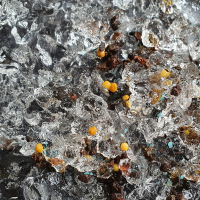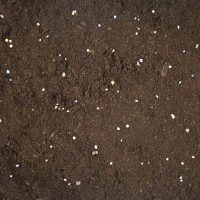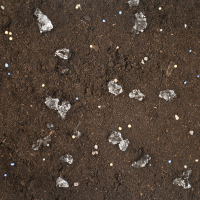- Home
- How many “life cycles” does TerraCottem have?
How many “life cycles” does TerraCottem have?
18/05/2021 - 00:00
The answer is more complicated than the question. The question is also related to this one: "how long does TerraCottem last?". The answer is complex and requires us to break down the soil conditioners into their main groups of components as each group has a different lifespan.
The composition of TerraCottem
The TerraCottem soil conditioners are a proprietary mixture of more than twenty components, which can be divided into 5 different groups:
- All our soil conditioners include growth precursors or biostimulants. They play a very important role in the initial growth phase of the plant. Their lifespan is limited and they only have 1 life “cycle” (once “consumed” by the plants, their purpose is fulfilled).
- All our soil conditioners include fertilisers. Nevertheless, the fertiliser composition of TerraCottem Universal, TerraCottem Turf and TerraCottem Arbor is different. Only TerraCottem Complement (which is a “top-up” product) has the same composition as TerraCottem Universal. Despite the differences, the idea behind it is similar: there are mineral soluble fertilisers that start to work upon first contact with water and slow-release fertilisers that have a longer lifespan (in the last category we have both coated fertilisers and synthetic organic fertilisers: the speed in which they release their nutrient content depends on parameters such as temperature, soil microbiology, etc). Their lifespan is limited and they also have only 1 life “cycle”.
- TerraCottem Universal, TerraCottem Complement and TerraCottem Arbor contain lava as carrier material. In TerraCottem Turf it is zeolite. Their lifespan is basically “unlimited” (“weathering occurs at a very slow pace).
- TerraCottem Arbor and TerraCottem Turf contain humates. Degradation into humic and fulvic acids depends on soil and climatological parameters.
- All TerraCottem soil conditioners contain cross-linked hydro absorbent polymers. The composition, types and amount present in the mixtures depend on the TerraCottem soil conditioner type. They are the only component that have more than 1 “life cycle”.
So, we can boil down the question to: how many “life cycles” do the TerraCottem polymers have?
Naturally occurring degradation mechanisms
The total “longevity” of polymers is difficult to estimate. They are constructed in such a way that they will last for a long period of time. Thus, a certain stability is indispensable, including the stability against microbial attack.
However, basic research has shown that polymers are prone to naturally occurring degradation mechanisms. At present, it is not possible to track the transition of the TerraCottem polymers from an additive to soil into the humus fraction under naturally occurring conditions by analytical means. The process is based on theoretical considerations, many years of experience and scientific data from laboratory analyses.
Every year, they “loose” some of their swelling capacity due to solubilization, internalisation and subsequent mineralization of the constituent parts of minerals and nutrients, ammonia, carbon dioxide and water, with no residual toxicity. The lifespan of the TerraCottem polymers is minimum 8 years:
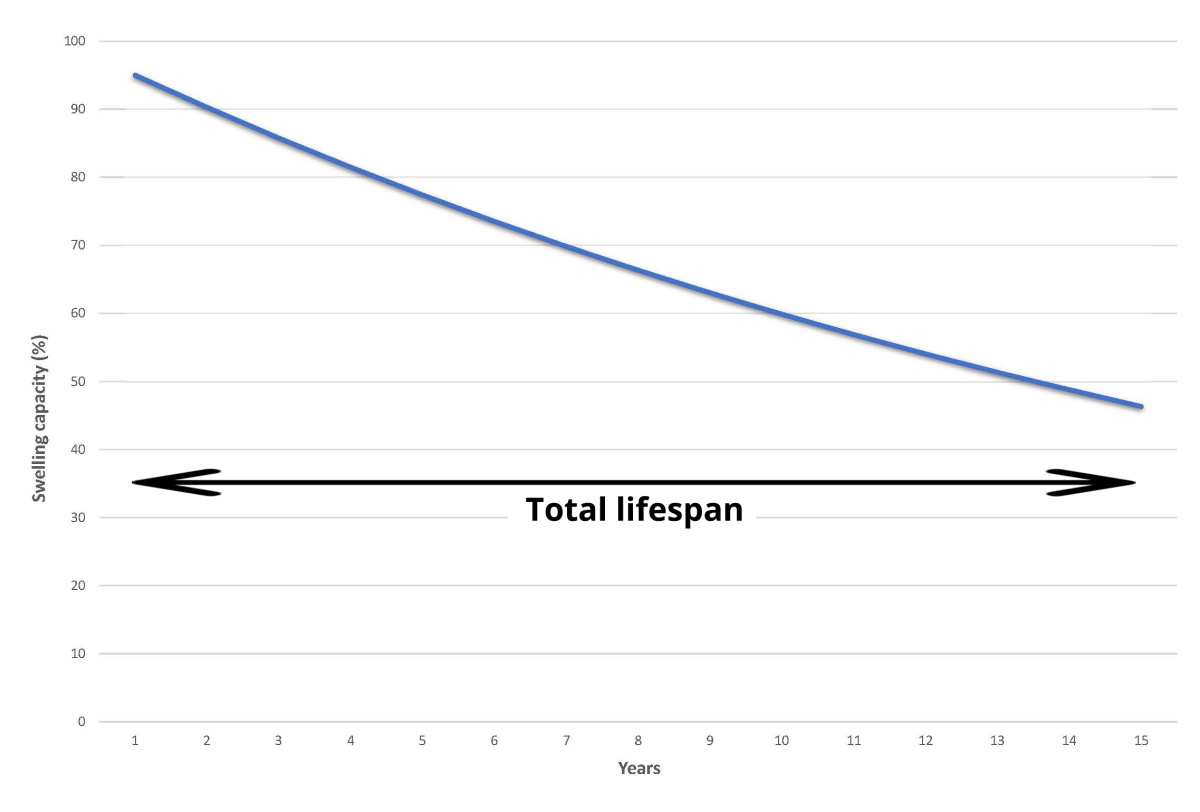
During their total lifespan, these polymers undergo numerous “dry/wet – cycles”:
- They absorb water: the polymers “swell”.
- The plant roots use that water: the polymers “shrink”.
- When new water is added (irrigation and/or natural precipitation), the polymers swell again…
- And so on.
It is impossible to predict HOW LONG a polymer will last and HOW MANY cycles they can have.
Why? Because it depends on many factors. For instance, some of the cycles will be short (wet periods, high water consumption), some of them long (dry periods, limited water consumption):
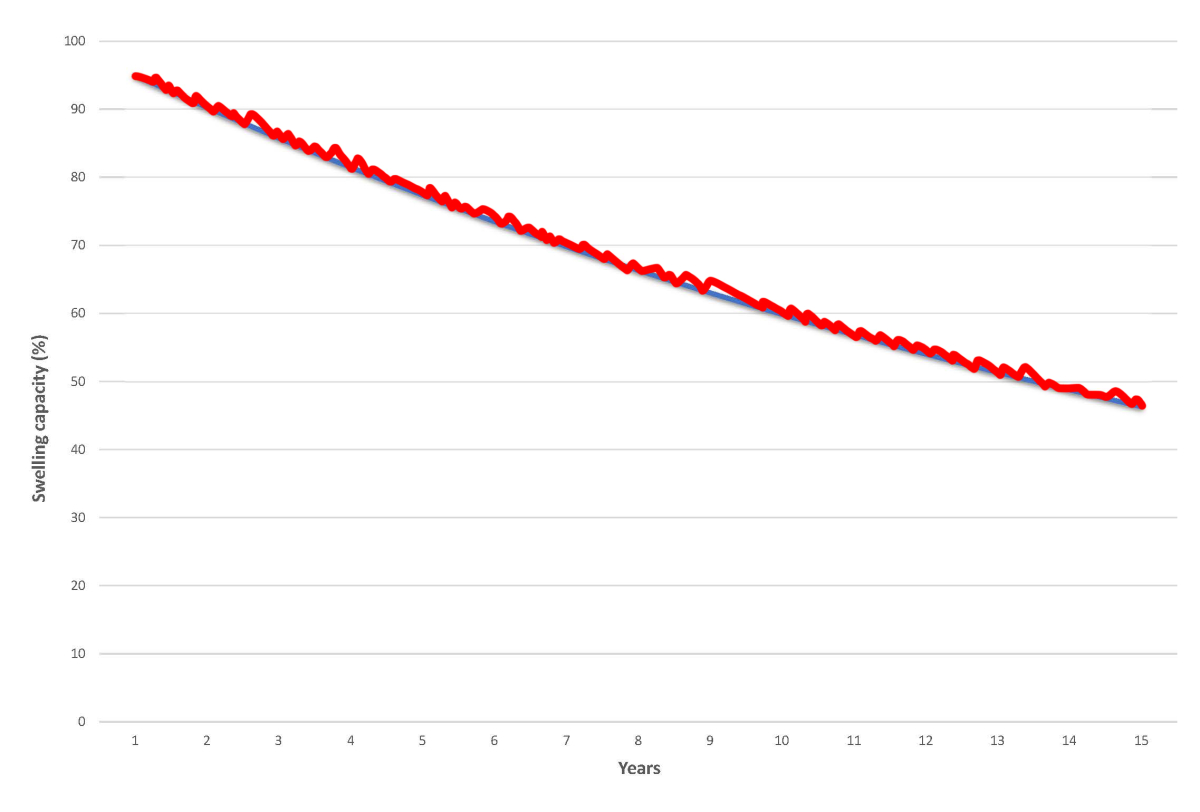
TerraCottem R&D department
Our research department is currently performing a trial which started in March 2012. That is more than 9 years. One of TerraCottem’s polymers is already in its 81st cycle. And this is a trial of “extremes”: each time starting from saturation until a moisture level of only 10% of the initial saturation weight remains. This situation does not occur under natural conditions. We expect to end this trial in March 2022 to obtain an observation period of exactly 10 years. So, keep an eye out on this page for an update.
If you know someone who would also like to read this article, feel free to share:
Take me back to the Frequently Asked Questions
We are happy to answer any further questions:
continue to our webformWe are happy to answer any further questions:
continue to our webformTerraCottem Intl. SL
Apartado de Correos 4511190 Benalup (Cádiz)Spain

